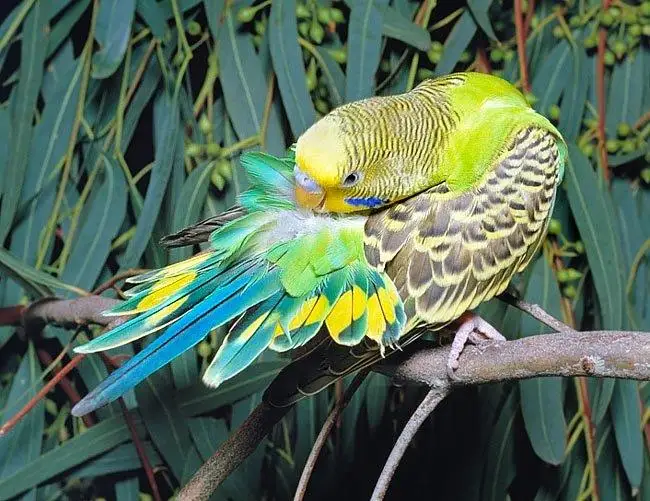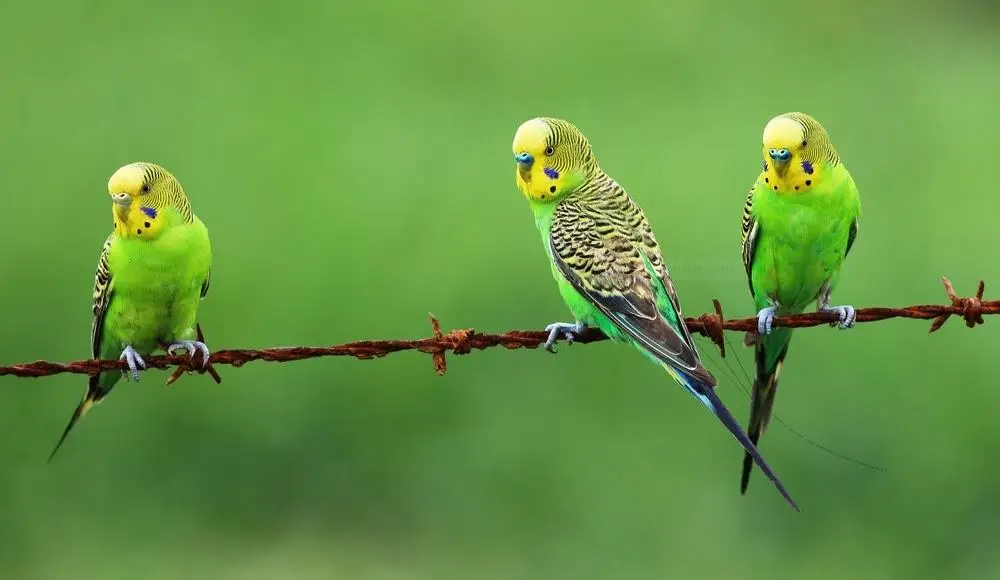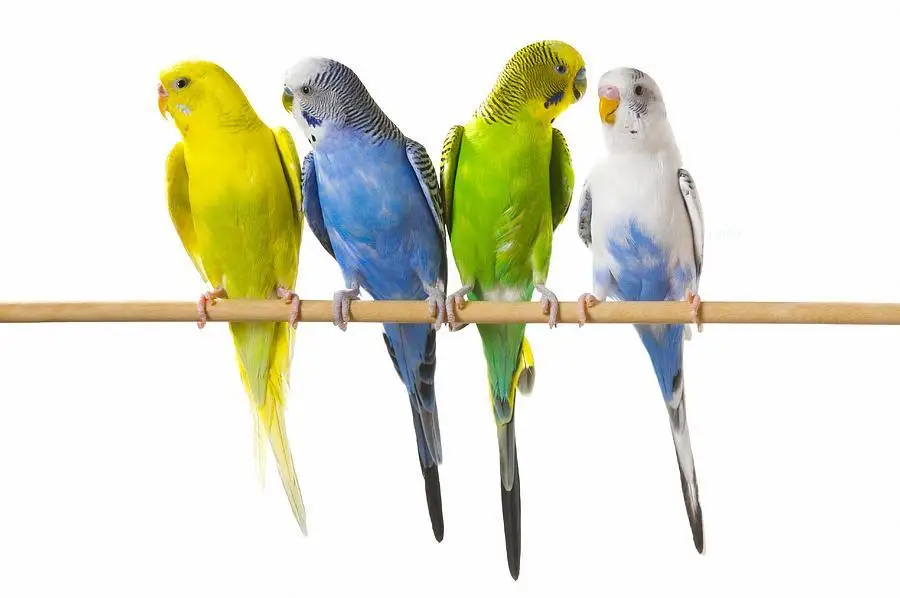Variety Overview
English Name: Melopsittacus undulatus
Aliases: Yellow-backed Green Parrot, Yellow-spined Green Parrot, or Yellow-spined Green Cockatoo
Origin: Native to Oceania, widely found in the inland regions of Australia
Size: Small
Care Level: Easy to care for
Morphological Features and Identification
Budgerigars (commonly known as budgies) are small parrots that measure about 18 centimeters in length including their tails. Domesticated budgies tend to be slightly larger than their wild counterparts. Wild budgies typically exhibit a yellow-green coloration overall.
The head and back feature fine black horizontal stripes over a yellow-green background resembling tiger stripes—hence their name “budgerigar.” Their waist, chest, and abdomen areas remain green while their tails match almost perfectly in length to their bodies—with two central tail feathers being longest at dark green hues surrounded by symmetrically arranged green ones.
From beak to neck they display unstriped yellow feathers along with an oval-shaped blue-purple spot on each cheek side complemented by near-circular black spots around its neck like wearing necklaces.
Male & female budgies share similar coloring except for differences in cere color—males showing either bluish-white/blue during breeding seasons or deep blues when older while females show flesh/light-flesh tones during breeding seasons transitioning into ginger hues when aged though relying solely upon cere coloration proves inaccurate distinguishing between sexes accurately enough alone! Their hooked yellowish beaks function much akin claws aiding climbing efforts alongside rounded eyes bearing dark irises hidden beneath short feather-covered tarsi housing zygodactyl toes perfect gripping!
Wild types exhibit predominantly yellow-green bodies interspersed amongst light browns atop heads/necks/upper backs/wing coverts featuring individual feather patterns blending yellows/blacks together seamlessly whilst throats/faces shine purely golden yellows beneath cheeks showcasing varying degrees bluish-purples punctuated three distinct throat-spots lined narrowly edged chest-feathers!
Primary flight features light blues transitioning grey-greens streaked lighter shades inwardly spotted whites centered atop tails’ uppermost segments boasting vibrant blue-greens tipped blacks inwardly shaded jet-black finishes! Olive-yellowish beaks accompanied bluish ceres highlight white-irised eyes completing visual spectacle whereas females’ grey-browns/flesh tones speckled faintly bluish nuances deepen into darker browns come breeding times! Juveniles bear darker hues initially evolving pinkish ceres gradually maturing adult plumages within three-four months span!
Average lifespan spans seven years measuring sixteen-eighteen centimeters weighing thirty-five grams donning foreheads/faces decked golden yellows cheeked purple-blues densely striped upper bodies mixing yellows/blacks down waists/lower regions greens throated mini-black spotted tails’ greens-blues eye-whites grey-beaked grey-blue footed beings!
Juvenile males’ pinkish ceres vary breeds females’ whitish-blue nuances aligning breeds respectively adults round-flat topped heads strong hooked ceres-covered upper beaks vibrant varied plumages spanning yellows/greens/blues/whites/light-yellows displaying iconic namesake horizontal stripings adorning heads/necks/backside plumes favoring branch-climbing object-gripping feeding activities via zygodactyl toe arrangements second-third forward first-fourth backward elongated arrow-like central tail-feathers distinguishing adult males’ blues versus females’ browns dry-lusterless bases/toe pale-flesh tones!

Maintenance Tips
For pet purposes, small electroplated metal cages with perches and hanging rings provide ample space for play. For breeding purposes, larger square metal cages measuring 50 cm by 35 cm by 35 cm are ideal. These cages should have a drawer-style sand tray at the bottom for easy cleaning of droppings.
The nesting box should ideally mimic natural conditions—a horizontal box is preferable but vertical boxes work well too. A suitable size would be a rectangular wooden box measuring 25 cm by 14 cm by 14 cm with an internal partition creating two chambers: an outer chamber with a 6-cm diameter hole leading outside and an inner chamber with a similar hole of 4-cm diameter for access between chambers.
Daily fresh water changes are necessary along with weekly cleaning of droppings. During summer months, avoid placing the parrot in direct sunlight. Use galvanized metal cages over painted or plastic-coated ones to minimize chemical exposure risks.
When free-ranging clipped-wing birds, ensure they have a designated area to prevent them from wandering off too far. Return all non-breeding birds to their cages at dusk as they tend to hide overnight otherwise—be cautious of predators like mice and snakes.
Temperature Control
Keep indoor temperatures above 16°C in winter and ensure proper ventilation during summer when temperatures exceed 30°C.

Feeding Techniques
The recommended feed mix for small parrots includes: 7 parts millet or sorghum, 2 parts barnyard millet, and 1 part perilla seed. These birds also enjoy cabbage and rapeseed. Additionally, it’s important to provide mineral supplements like cuttlebone or shells. Captive-bred budgerigars prefer darker nesting areas for laying eggs; overly bright nests can negatively impact hatching success. Typically provided artificial nesting boxes have two compartments: an outer chamber with an entrance connected to the cage and an inner chamber with a hole in between for access. The inner chamber should be lined with sawdust or fine sand for egg-laying and incubation. Recommended dimensions for these boxes are: length 25 cm (9.8 inches), width 13 cm (5.1 inches), height 13 cm (5.1 inches); with a nest entrance diameter of about 5-6 cm (2-2.4 inches) positioned 6-7 cm (2.4-2.8 inches) above the bottom.
In Beijing’s climate, budgerigars breed during autumn, winter, and spring seasons but generally stop during summer due to high temperatures which can harm both parent birds’ health and reduce hatching success rates significantly. Poor chick health often results from summer breeding attempts; thus it’s common practice to remove nesting boxes from July to September each year for cleaning and disinfection before reinstating them in October.
Foods that budgerigars should avoid include:
Spinach, pears, onions, cherries; seeds from Rosaceae family plants (though apple flesh is safe); bitter melon; mushrooms; peaches; plums; scallions; excessive salt intake; insect shells like shrimp or crab shells; sorrel (wild spinach); wood sorrel; ivy among others.
Italian dishes such as pizza or pasta containing onions or mushrooms are also unsuitable for them.
